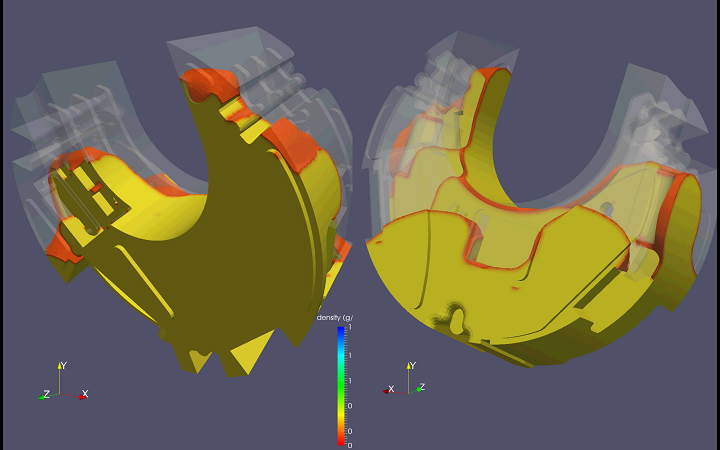Simulation First Initiative Helps Honeywell Engineers Find Optimal Parameters for 3D Printed & Machined Parts
 Honeywell FM&T, an engineering, manufacturing and sourcing enterprise that’s part of aerospace company Honeywell, manages and operates the Kansas City National Security Campus (KCNSC) for the US Department of Energy (DOE). In addition to providing technical services like metallurgy, analytical chemistry, and simulation tools, its mission is to make non-nuclear mechanical, electronic, and engineered material components for national defense systems. Honeywell and the KCNSC are collaborating with Sandia National Laboratories on a new initiative called Simulation First.
Honeywell FM&T, an engineering, manufacturing and sourcing enterprise that’s part of aerospace company Honeywell, manages and operates the Kansas City National Security Campus (KCNSC) for the US Department of Energy (DOE). In addition to providing technical services like metallurgy, analytical chemistry, and simulation tools, its mission is to make non-nuclear mechanical, electronic, and engineered material components for national defense systems. Honeywell and the KCNSC are collaborating with Sandia National Laboratories on a new initiative called Simulation First.
Sim First was launched by Honeywell engineers at the campus, and is helping them reduce costs, while driving manufacturing speed and productivity, at the same time – before they even reach the prototype stage.
“The effort uses physics-based tools to simulate production operations – all while in the concept phase,” Tanya Snyder, the Communications Manager for Honeywell and a Contractor for the KCNSC, told 3DPrint.com. “This reduces the number of tests required to find the right process and manufacturing parameters for 3D-printed and traditionally machined parts, resulting in less cost and production time.”
This strategic partnership marries Sandia’s code development skillset with the KCNSC’s use of simulation in critical and continuing production processes. In the past, the KCNSC has partnered with Sandia on 3D printing replacement parts for a nuclear warhead, and has also worked with Honeywell on tool design.
Before Honeywell’s ideas even leave the concept phase, the Sim First program uses tools and algorithms to figure out when and where materials could break, in addition to how well they will stand up under extreme temperatures and shock…obviously important when it comes to applications regarding the country’s national security. The program lets the engineers know if their parts are the right firmness, structure, and weight. Finally, calculations will optimize the final design and develop the optimal manufacturing parameters and processes for the product, whether they’re traditionally or additively manufactured parts.
Snyder provided us with a good example of how Sim First works that involves creating foam parts, which, because of their processing procedures and complicated chemical make-up, have always had low production yields in the past.
“Under SimFirst, the KCNSC and Sandia worked together to find a way to predict the expansion of Polyurethane foam in an enclosure,” Snyder explained.
“Sandia developers created a model that’s now been applied 400+ times at the KCNSC. The model predicts the fill behavior of every encapsulated component being developed for production. The end result has been the creation of fewer physical prototypes and a faster development schedule.”
In the above image, you can see an encapsulation fill simulation, which provides Honeywell engineers with the product’s “optimal density and fill levels,” all before they even start to work on the final prototype itself. Early access to this kind of data can really help lower the costs and time that are part of the life cycle of product development.
What do you think about this initiative? Discuss this story and other 3D printing topics at 3DPrintBoard.com or share your thoughts in the Facebook comments below.
Subscribe to Our Email Newsletter
Stay up-to-date on all the latest news from the 3D printing industry and receive information and offers from third party vendors.
You May Also Like
Gorilla Sports GE’s First 3D Printed Titanium Cast
How do you help a gorilla with a broken arm? Sounds like the start of a bad joke a zookeeper might tell, but it’s an actual dilemma recently faced by...
Nylon 3D Printed Parts Made More Functional with Coatings & Colors
Parts 3D printed from polyamide (PA, Nylon) 12 using powder bed fusion (PBF) are a mainstay in the additive manufacturing (AM) industry. While post-finishing processes have improved the porosity of...
$25M to Back Sintavia’s Largest Expansion of Metal 3D Printing Capacity Since 2019
Sintavia, the digital manufacturing company specializing in mission-critical parts for strategic sectors, announced a $25 million investment to increase its production capacity, the largest expansion to its operations since 2019....
Velo3D Initiates Public Offering in a Bid to Strengthen Financial Foundations and Drive Future Growth
Velo3D (NYSE: VLD) has been among a number of publicly traded 3D printing firms that have attempted to weather the current macroeconomic climate. After posting a challenging financial report for 2023,...

































